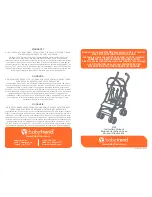
Appendix “B”
Regulations and Guidelines
B-1
OSHA Regulations
1910.217 (C) (3) (iii)
Safeguarding the Point of Operation
(iii) A presence sensing point of operation device shall
protect the operator as provided in paragraph (c) (3)
(i) (a) of this section, and shall be interlocked into the
control circuit to prevent or stop slide motion if the
operator’s hand or other part of his body is within the
sensing field of the device during the downstroke of the
press slide.
(a) The device may not be used on machines
using full revolution clutches.
(b) The device may not be used as a tripping
means to initiate slide motion.
(c) The device shall not be constructed so that a
failure within the system does not prevent the
normal stopping action from being applied to
the press when required, but does prevent the
initiation of a successive stroke until the failure
is corrected. The failure shall be indicated by
the system.
(d) Muting (bypassing of the protective function)
of such device, during the upstroke of the press
slide, is permitted for the purpose of parts
ejection, circuit checking, and feeding.
(e) Refer to ANSI B11.19-2010 for calculating
safety light curtain distance from the point of
operation.
(f) Guards shall be used to protect all areas of
entry to the point of operation not protected by
the presence-sensing device.
1910.217 (C) (3) (iii)
Additional requirements for safeguarding
Where the operator feeds or removes parts by placing
one or both hands in the point of operation, and a two
hand control, presence sensing device or Type B gate
or movable barrier (on a part revolution clutch) is used
for safeguarding:
(i) The employer shall use a control system and
a brake monitor which comply with paragraphs
(b) (13) and (14) of this section.
(e) Inspection, maintenance, and modification of
presses-
(i) It shall be the responsibility of the employer
to establish and follow a program of
periodic and regular inspections of his
power presses to insure that all their parts,
auxiliary equipment, and safeguards are in
a safe operating condition and adjustment.
The employer shall maintain records of
these inspections and maintenance work
performed.
1910.212
General requirements for all machines (covers
press brakes, hydraulic and pneumatic machines
not covered by mechanical power press standards).
(a) Machine guarding - (1) Types of guarding.
One or more methods or machine guarding shall
be provided to protect the operator and other
employees in the machine area from hazards
such as those created by point of operation
ingoing nip points, rotation parts, flying chips,
and sparks. Examples of guarding methods are:
barrier guards, two-handed tripping devices,
electronic safety devices, etc.
These are only partial reprints,
refer to your Federal Register for total construction,
control reliability, and machine guarding requirements
for the subject machine being guarded for all applicable
OSHA Standards.
Machine Control Reliability
Requirements
Control Reliability
“...control circuits shall be designed and constructed so
that a single failure or fault within the system does not
prevent the normal stopping action from being applied
to the press when required, or does not create an
unintended stroking action, but does prevent initiation of
a successive stroke until the failure is corrected” (ANSI
B11.1-2009).
“...control shall be designed to prevent initiation of a
stroke signal in the event that a failure occurs within the
press control” (ANSI B11.2-2013).
“Robots shall be designed and constructed so that any
single, reasonably foreseeable failure will not cause
hazardous motion of the robot” (ANSI/RIA R15.06-
2012).
Содержание microguard
Страница 1: ...Installation Manual for the Metal Box Controller Module ...
Страница 45: ...NOTES ...
Страница 46: ...NOTES ...











































